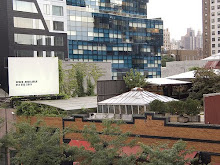


1) An Overview of Bryant Park in the 1930s. 1934 (Bryantpark.org). 2)
Location: Bounded by Fifth and Sixth Avenues & 40th and 42nd Streets
Directions: B, D, F, V Train to Bryant Park
During the Roaring 20s, Bryant Park was already a prostitution haven. The scene was trickled down from the city’s epicenter of prostitution, Times Square, just two avenues over.[1] Then, the park was redesigned in 1933-1934 as a Great Depression public works project. The new park featured a lawn, hedges and later, an iron fence to separate the park from the surrounding city streets.
In the 1970s, the expansion of NYC resulted in changes in the landscape surrounding Bryant Park as the construction of an above ground subway line running around the park created a public space virtually cut off from the surrounding city life. A person could pass the park and be completely unaware of the activities within. This made it appealing for drug dealers, prostitutes and the homeless. The park was nicknamed "Needle Park" due to profuse heroin use, and was considered a "no-go zone". Soon, Bryant Park was identified as a symbol of New York City’s decline.
In addition, Biederman worked with William H. Whyte, an American sociologist and scholar of public space. They implemented two vital decisions which ultimately renewed this public space. First, they decided to place movable chairs in the park as they provide people with a sense of “empowerment”, allowing them to sit in whichever way they desire. Second, they decided to lower the park itself. Until 1988, Bryant Park had been elevated from the street and further isolated by tall hedges, a layout which fostered illegal activity. The 1988 renovation lowered the park to nearly street level and tore out the hedges. Interestingly, Biederman also demanded that the public restroom be renovated luxuriously because it was a way for visitors to gauge the cleanliness of the general environment. Moreover, Biederman believed that an important barometer of how safe a public space is perceived is the ratio of women to men in the attendance, as a 50-50 split between men and women is ideal. Therefore, he argued for bringing more feminine ideas and attractions into the park[3].
After a four-year effort, the park reopened in 1992 to widespread success, as the upscale atmosphere dramatically improved local office rents and occupancy rates. Today, the park provides restaurants, fancy concession kiosks, carousel, an open-air library, and a skating rink. In the 28 years since the renewal by the BPC, the park has become one of Manhattan’s most admired and most visited public sites. More importantly, it was a symbol of one of the greatest urban renewals, as New York Magazine called it "the BEST example".[4]
[1] Chauncey, George. Gay New York: Gender, Urban Culture, and the Making of the Gay Male World, 1890-1940. Basic Books, 1995.
[2] Wilson, James and Kelling, George. Broken Windows: The Police and Neighborhood Safety. http://www.manhattan-institute.org/pdf/_atlantic_monthly-broken_windows.pdf. Retrieved 12/04/2009.
[3] Malone, Karen. Children, Youth and Sustainable Cities. Local Environment, Vol. 6, No. 1, 5–12, 2001. http://unpan1.un.org/intradoc/groups/public/documents/APCITY/UNPAN012799.pdf. Retrieved 12/04/2009.
[4] "Best Example of Urban Renewal" New York Magazine December 20, 1993

If we compare old and new picture of Bryant Park, we might see a little bit difference between them. Travelers would be happy to enjoy this nice place. best park and fly deals
ReplyDelete